-
Courses

Courses
Choosing a course is one of the most important decisions you'll ever make! View our courses and see what our students and lecturers have to say about the courses you are interested in at the links below.
-
University Life

University Life
Each year more than 4,000 choose University of Galway as their University of choice. Find out what life at University of Galway is all about here.
-
About University of Galway

About University of Galway
Since 1845, University of Galway has been sharing the highest quality teaching and research with Ireland and the world. Find out what makes our University so special – from our distinguished history to the latest news and campus developments.
-
Colleges & Schools

Colleges & Schools
University of Galway has earned international recognition as a research-led university with a commitment to top quality teaching across a range of key areas of expertise.
-
Research & Innovation

Research & Innovation
University of Galway’s vibrant research community take on some of the most pressing challenges of our times.
-
Business & Industry

Guiding Breakthrough Research at University of Galway
We explore and facilitate commercial opportunities for the research community at University of Galway, as well as facilitating industry partnership.
-
Alumni & Friends

Alumni & Friends
There are 128,000 University of Galway alumni worldwide. Stay connected to your alumni community! Join our social networks and update your details online.
-
Community Engagement

Community Engagement
At University of Galway, we believe that the best learning takes place when you apply what you learn in a real world context. That's why many of our courses include work placements or community projects.
2010
All Year 2010
Colonialism Conference returns to NUI Galway
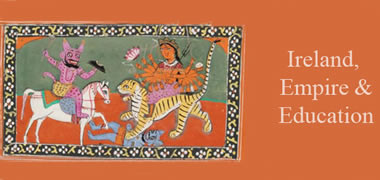
Tuesday, 22 June 2010
NUI Galway will host its sixth Conference on Colonialism entitled "Education and Empire" from 24-26 June 2010. The aim of this interdisciplinary event is to explore the role of education in shaping, promoting, and challenging imperial and colonial ideologies, institutions and processes throughout the modern world. The 2010 conference, organised in co-operation with TCD and the IRCHSS-sponsored inter-university research project, 'Ireland, Empire and Education', continues the prestigious tradition of a highly successful series of conferences, which has created an expanding network of international associations between Galway and institutions and individuals in continents across the world. The role of higher education in Ireland's colonial history and postcolonial present will be specifically addressed, as well as the relationship between these institutions and colonial power structures. Topics to be discussed at the conference range from missionary education to museums, from school stories to penal colonies, and from universities in the settler colonies to decolonization through education. Keynote speakers include; Professor John Coolahan, Emeritus, NUI Maynooth, Professor Gauri Viswanathan, Columbia University, New York and Professor Sanjay Seth, Goldsmiths, University of London. The "Ireland, Empire and Education" research project was established to examine the complex relationships which developed between Irish universities and higher educational institutes and the British Empire, 1840-1940. This project draws on the existing interests of staff in the TCD School of Histories and Humanities as well as those of collaborators in NUI Galway and Queen's University Belfast. Dr Muireann O'Cinnéide, Director of the MA in Culture and Colonialism at NUI Galway, says: "It is particularly interesting to host this conference in NUI Galway as it allows us to consider the relationship between Ireland's rich educational tradition and its colonial history in the context of a wealth of different international perspectives and histories. The conference holds great relevance to academic programmes offered at NUI Galway and it promises to be a stimulating and challenging three days". Further information is available via www.conference.ie or from educationandempire@nuigalway.ie Ends
>> Read full story about Colonialism Conference returns to NUI Galway
Minister Launches Three-way Youth Development Partnership for Youth in Africa
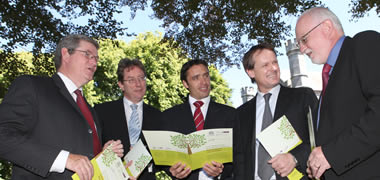
Monday, 21 June 2010
A partnership between NUI Galway's UNESCO Chair in Children Youth and Civic Engagement at the Child and Family Research Centre, Foróige, the National Youth Development Organisation and Alan Kerins Projects, a Non Governmental Organisation (NGO) will be launched today, Monday, 21 June, 2010, in NUI Galway by the Minister of State with special responsibility for Overseas Development, Peter Power T.D. Through the work of NUI Galway's Professor Pat Dolan, the UNESCO Chair in Children Youth and Civic Engagement at the Child and Family Research Centre, the overarching aim of this partnership is to further the long standing commitment of UNESCO to address the challenges facing youth and to foster young people's participation in the development of their societies, with an initial focus on Zambia where each organization has well-established links. As a first step the partnership intends to initiate a pilot project in the Kaoma district in the Western Province of Zambia targeting youth affected by HIV/AIDS. The partnership will encompass activities across the core areas of the Chair's work which includes: research, teaching, policy, advocacy and programme development. The partnership is currently developing a model for a youth centre, which integrates youth work and sport. Using sport as the initial medium to reach out to young people, the proposed youth centre will provide a forum for youth to actively participate in a range of activities that extend beyond sport, including active citizenship and youth leadership programmes and life skills training. The partnership will also work closely with the University of Zambia to further facilitate access, sharing and adaption of knowledge between the two regions. The NUI Galway UNESCO Chair in Children, Youth and Civic Engagement through dedication to practice and policy orientated research on youth, along with its partners, Foróige, Alan Kerins Projects, an NGO working directly with children and young people in Zambia investing in health, education and sports services, are well placed to work in partnership towards furthering UNESCO's goals. Established in 2009, the UNESCO Chair is engaged in forming alliances between academic institutions and non-governmental organizations, youth work professionals and UN System agencies with a shared interest in promoting civic engagement for children and youth. The associated programme of work promotes the educational value of civic engagement and highlights its potential as a means of fostering resilience and enhancing social support networks for disadvantaged children and youth. Increasing access to appropriate learning and life-skills programmes and promoting youth participation and leadership are key areas employed by governments and civic society organizations working with youth at risk. As part of its ethos, NUI Galway has a specific commitment to embracing community and civic engagement as a core part of its mission. Welcoming the announcement, NUI Galway President, Dr James J. Browne, said "We look forward to fruitful co-operation with our partners on the ground in Zambia and to building new structures for co-operation with universities and NGOs through an exchange of research, training and policy initiatives." Speaking at the launch today, Minister of State for Overseas Development, Peter Power, T.D., said: "I am delighted to launch this partnership between the Alan Kerins Project, the UNESCO Chair of Children, Youth and Civic Engagement and Foróige. It is a clear demonstration of the commitment and enthusiasm within Ireland to find new and dynamic ways to assist those living in poverty and to end suffering in the developing world". "All of us gathered here today share a deep interest in Zambia, which is a priority country for Irish Aid, the Government's programme for overseas development. The key aim of Ireland's long-term development programme in Zambia is the reduction of chronic poverty and inequality. To this end, we work with in partnership with the Government of Zambia and other donors", the Minister added. "The Irish Aid programme in Zambia is focused on improving the quality of and access to education; reducing poverty in a coordinated and effective manner; tackling the scourge of HIV and AIDS and building good governance in order to ensure that the Zambian people are fully informed of and engaged in their country's development. "I know that we share many of the same goals and look forward to learning more about the experiences and successes of this innovative partnership over the months and years to come", concluded Minister Power. According to Alan Kerins, "All of us involved with the Alan Kerins Projects are embracing this new initiative with all our resolve and efforts. In welcoming our new strategic partners, UNESCO and Foróige, I am confident that our focus on Youth and Civic Engagement will continue to inspire us in supporting our friends in Zambia through concrete plans and programmes. The world would otherwise have forgotten these communities were it not by chance that I visited them in 2005. I witnessed firsthand their severe daily challenges and promised to help their plight. We are indebted and welcome this new initiative through genuine friendship which will help us all grow our activities for the betterment of our brothers and sisters". -Ends-
>> Read full story about Minister Launches Three-way Youth Development Partnership for Youth in Africa
Archaeology Open Day and Public Talk
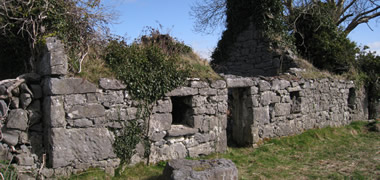
Monday, 21 June 2010
Life in Burren villages before, during and after the Famine An Archaeology Open Day and Public Talk has been announced by a team of Irish and US archaeologists who have started survey work at Lios an Rú, a 19th century deserted village on the hill above Newtown castle, Co. Clare. The Open Day, which will take place from 10am to 5pm on Sunday, 27 June will conclude with a talk on 'Lios An Rú and 19th century deserted villages around Ballyvaughan' at 7.30pm in the Burren College of Art in Newtown. All events are free and open to the public and sponsored by NUI Galway. The archaeologists involved are from NUI Galway and the State Museum of the University of New York State. Their work is part of an exciting new initiative at NUI Galway to investigate the daily lives and work of women, children and men in the Burren before, during and after the Famine. The project will have a number of elements including research, education and community archaeology. The distinguished US Professor, Charles Orser is co-directing the project with NUI Galway archaeologist Maggie Ronayne. He is distinguished Professor Emeritus at Illinois State University, Curator of Historical Archaeology at the New York State Museum and an adjunct professor at NUI Galway. Professor Orser is a historical archaeologist and uses anthropology and archaeology to investigate the lives of men and women ignored by official, written history and their interactions with people of power. For over a decade his field research has focused on the west of Ireland in the 19th century. Commenting on the Open Day, Maggie Ronayne of NUI Galway invited inputs from the public: "We are looking forward to hearing everyone's views. A lot of people have a great knowledge of how communities like these tenant villages in the Burren survived and what they accomplished before, during and after the famine. If your family came from these villages or you have information about their history, if you know of other deserted villages, have any questions or are just interested to know more, we'd love to meet you!" Anyone wishing to become involved in a community archaeology project related to the investigations is invited to come along and meet the archaeologists during the Open Day. -Ends-
>> Read full story about Archaeology Open Day and Public Talk
NUI Galway and UL Launch Translational Research Institute with the Georgia IT
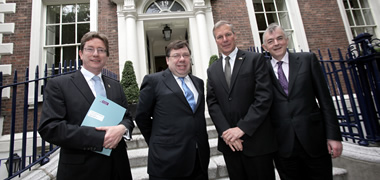
Friday, 18 June 2010
An Taoiseach Brian Cowen T.D. will today, (Friday, 18 June, 2010), unveil a unique partnership between NUI Galway and the University of Limerick with the Georgia Institute of Technology, USA to develop a joint Translational Research Institute. This development is one of the first initiatives to come out of the NUI Galway-UL Alliance launched earlier this year. The Translational Research Institute will focus on the development and synergy of core technologies and expertise within the partner institutions, to provide Irish industries with relevant and world-class research solutions. Welcoming the Initiative, An Taoiseach Brian Cowen, said: "I would like to commend all involved in establishing this Institute. It is exactly the type of development which the Government is trying to encourage. I believe it can help us achieve our goals for increasing collaboration between higher education institutions, establishing better linkages between higher education and industry, and delivering the economic growth and job creation we need in the years ahead." The Translational Research Institute has a very significant strategic importance nationally. There is now an increasing emphasis in Ireland on research that can have more immediate industrial and economic benefits, in order to build the 'smart economy' and a knowledge society. The proposed Translational Research Institute, with the backing of the Georgia Institute of Technology's long-standing and extensive track record of industry-focused research and technology development, will play a leadership role in this area. President of Georgia Institute of Technology, Dr G.P. "Bud" Peterson explained how the new partnership will also make it easier for Georgia Tech to conduct many large-scale applied research programs and will provide additional real-world research opportunities for Georgia Tech students. "Georgia Tech is building upon a successful working relationship with both universities that has already produced important research in such areas as use of radio-frequency identification (RFID) in medical inventory management and energy management for buildings, and in-home care of aging populations. Georgia Tech remains committed to research efforts in Ireland, and we feel the synergy with our Irish partners will be a pathway to long-term successful operations" he said. Both NUI Galway and the University of Limerick have strong track records in technology development and commercialisation, in addition to having international reputations for collaborating successfully with industry partners. This strong record of industry collaboration and world-class research in fields such as Biomedicine (the National Centre for Biomedical Engineering Science and Regenerative Medicine Institute at NUI Galway), Biomaterials (the Materials and Surface Science Institute at UL), renewable energy (at both Universities), internet technologies (Digital Enterprise Research Institute at NUI Galway), and software development (the Lero Institute at UL), support the national focus on innovation, and technology commercialisation for economic growth and development. These strengths and experience will benefit significantly from the long-standing track record and reputation for delivery in translational research enjoyed by the Georgia Institute of Technology and its associated applied research arm, the Georgia Tech Research Institute. The Institute will apply technologies developed within its partner institutions in the Healthcare and Sustainable Energy market segments. President of the University of Limerick, Professor Don Barry, said: "The Translational Research Institute is a very exciting development for the UL-NUI Galway Alliance. In this current environment, it is absolutely vital that we work together to form new partnerships and in turn deliver real results with real projects leading to the delivery of high value jobs. This Institute will champion the application of research to drive scientific and economic progress in our regions." The new Translational Research Institute will be a national centre of excellence in translational research, technology development and exploitation in key strategic areas of Science, Engineering, and Technology. It will create a unique translational facility in Ireland and will significantly enhance the capacity and expertise available to the broad higher education sector and Irish industry, providing a distinct competitive advantage for indigenous SMEs and Irish-based FDI industries, thus helping to establish Ireland as a global centre of excellence for technology development, innovation and commercialisation. Speaking at the announcement, President of NUI Galway, Dr James J. Browne, said: "Our partnership with Georgia Institute of Technology underlines the fact that both universities are working with the strengths and needs of our region, in the interest of the Irish economy and to the highest international standards. Georgia Institute of Technology have a longstanding and successful track record in bringing academic research to bear on problems facing industry and government. They have a record of success in translating academic research into products, processes and services which serve industry and generate economic wealth. We are proud that this new Translational Research Institute, Georgia Tech Ireland will bring this model to Irish Higher Education." -Ends-
>> Read full story about NUI Galway and UL Launch Translational Research Institute with the Georgia IT
10 Risk Factors are Associated with 90% of Risk of Stroke
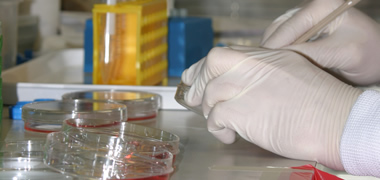
Friday, 18 June 2010
The INTERSTROKE study, published online and in an upcoming publication of medical journal Lancet, shows that a total of 10 risk factors (including high blood pressure, smoking, and waist-to-hip ratio) are associated with 90% of the risk of stroke. The international study, being presented today (Friday, 18 June) at The World Congress of Cardiology, Beijing, is written by Dr Martin O'Donnell of NUI Galway and formerly McMaster University and Dr Salim Yusuf, McMaster University, Hamilton, ON, Canada, and colleagues for the INTERSTROKE investigators. The contribution of various risk factors to the burden of stroke worldwide is unknown, particularly in countries of low and middle income where the largest burden of stroke occurs. In the first phase of the INTERSTROKE study, the authors aimed to establish the association of known and emerging risk factors with stroke and its primary subtypes, assess the contribution of these risk factors to the burden of stroke, and explore the differences between risk factors for stroke and heart attack. The authors used data from 6,000 people (3,000 cases of stroke and 3,000 controls) in 22 countries* worldwide, covering the period March, 2007 to April, 2010. Cases were patients with a first acute stroke (within 5 days of symptoms onset and 72 h of hospital admission). Controls had no history of stroke, and were matched with cases for age and sex. All participants completed a structured questionnaire and a physical examination, and most provided blood and urine samples. The authors calculated the increased risk and population-attributable risks (PARs) for the association of all stroke, ischaemic stroke, and intracerebral haemorrhagic stroke with selected risk factors. The authors found the following 10 risk factors to be significantly associated with stroke: high blood pressure, smoking, waist-to-hip ratio (abdominal obesity), diet, physical activity, lipids (fats), diabetes mellitus, alcohol intake, stress and depression, and heart disorders. Collectively, these risk factors accounted for 90% of the PAR for all stroke. These risk factors were all significant for ischaemic stroke (caused by a blood clot blocking a blood vessel in the brain), whereas high blood pressure, smoking, waist-to-hip ratio, diet, and alcohol intake were significant risk factors for intracerebral haemorrhagic stroke (bleeding into the brain tissue). The ratio of bad to good blood lipids (apolipoproteins) was an important risk factor for ischemic stroke but not for haemorrhagic stroke. When looking at individual risk factors, the authors say it is important to note that the individual PARs for risk factors do not add up to the overall PAR for all risk factors combined. This is because many risk factors are inter-related. The study also addresses each risk factor independently, and found that high blood pressure was the most important for stroke, since it was associated with one-third of the risk of all stroke, and increased the risk of stroke more than two-and-a-half fold compared with no history of high blood pressure. Smokers were at double the risk of stroke compared with non-smokers, and smoking was associated with one in five strokes. Professor Martin O'Donnell, NUI Galway explained: "The INTERSTROKE study is the first large standardised case-control study of risk factors for stroke in which countries of low and middle income were included, and where all cases completed a brain scan (usually a CT scan). Our findings showed that five risk factors accounted for more than 80% of the global risk of all stroke (ischaemic and intracerebral haemorrhagic): hypertension, current smoking, abdominal obesity, diet, and physical activity. With the addition of five other risk factors, including apolipoproteins, the PAR for all stroke rose to 90%." The authors highlight that nine of ten risk factors (not including cardiac disorders) in INTERSTROKE are the same as in INTERHEART (also led by Dr Yusuf) which looked at risk factors for heart attacks. The relative importance of many of these risk factors is different for stroke and heart attack. For example, blood pressure is the most important risk factor for stroke, while blood lipids (fats) are the most important risk factors for heart attack. However, the nine risk factors in INTERHEART covered 90% of the PAR for heart attacks. They add that this work proves that a large international epidemiological study of stroke that requires routine neuroimaging is feasible in countries of low and middle income, and conclude: "Targeted population-based interventions that reduce blood pressure and smoking, and promote physical activity and a healthy diet, could substantially reduce the global burden of stroke." The investigators are currently undertaking Phase 2 of INTERSTROKE, which will include Ireland, aims to include 20,000 participants. This second phase will determine the importance of risk factors within different regions, different ethnic groups, and within ischemic stroke subtypes. In addition, the association between genetics and risk of stroke will be studied—this will require large sample sizes. In an accompanying Comment, Dr Jack V Tu, Institute for Clinical Evaluative Sciences, Sunnybrook Schulich Heart Centre, University of Toronto, Toronto, ON, Canada, says: "Whilst hypertension is well established as the most important cause of stroke in high-income countries, INTERSTROKE confirms that it is also the most important risk factor for stroke in developing countries. This finding is particularly relevant because it highlights the need for health authorities in these regions to develop strategies to screen the general population for high blood pressure and, if necessary, offer affordable treatment to reduce the burden of stroke. It also provides an impetus to develop population-wide strategies to reduce the salt content in the diet of individuals in these countries." -Ends-
>> Read full story about 10 Risk Factors are Associated with 90% of Risk of Stroke















